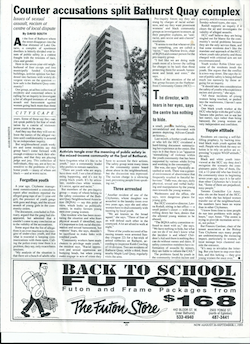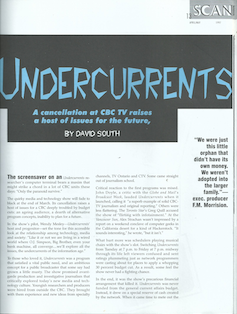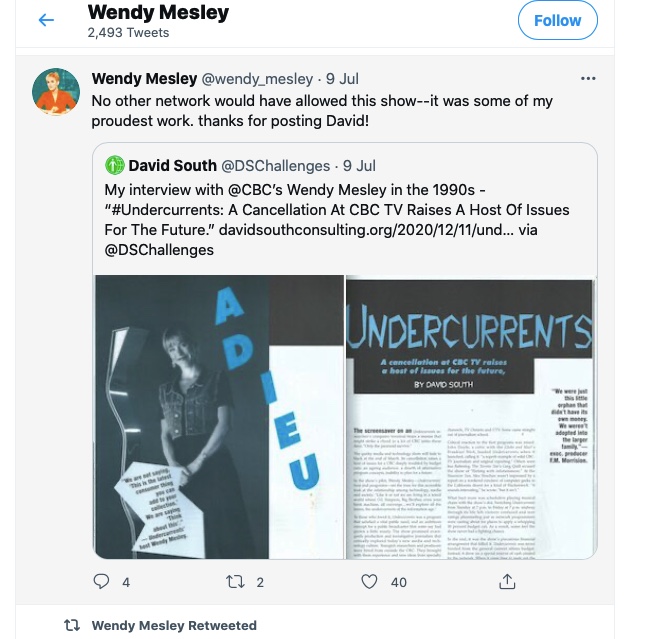Counter accusations split Bathurst Quay complex: Issues of sexual assault, racism at centre of local dispute
 Saturday, June 13, 2015 at 1:22PM
Saturday, June 13, 2015 at 1:22PM
By David South
Now Magazine (Toronto, Canada), August 26-September 1, 1993
At the foot of Bathurst where the street disappears into the blue shimmer of Lake Ontario, a complex of apartment dwellers is bitterly divided over issues of public safety in a contest fraught with the tensions of race, class and gender.
Here in the seven-year-old neighbourhood of four co-ops and two municipally funded Cityhome buildings, activist opinion has hardened into factions with widely divergent views on one question – how safe is the Bathurst Quay community?
One group, an ad hoc collection of residents and concerned others is calling for an inquiry to investigate a list of alleged instances of sexual assault and harassment against women going back more than three years. Some of these say they cannot speak publicly for fear of retaliation by a coterie of violence-prone youth in the area.
And they say that they will not release the names of the alleged victims until confidentiality is assured by an independent inquiry.
But neighbourhood youth workers and some residents say this group hasn’t come forward with enough evidence to back their allegations, and that they are playing judge and jury. This collection of individuals, they say, are at best insensitive to the problems of Cityhome youth – many of whom are black – and at worst racist.
Forgotten youth
A year ago, Cityhome management commissioned a consultants report after residents reported the alleged gang rape of an 11-year-old girl, the presence of youth gangs with guns and drugs, and the sexual assault of young girls in the community centre.
The document, concluded in February, argued that the gang had disappeared, but admitted that it couldn’t come to any conclusion as to the validity of the accusations.
Some argue that the list of allegations is an over-reaction to the energies of under-class youth, and that what is essential is keeping communications with them open. Calling the police every time there is a problem, they say, only exacerbates tensions.
“My analysis of the situation is that there are a bunch of adults who have forgotten what it’s like to be youth,” says a community leader who prefers to remain nameless.
“There are youth who are angry, have done stuff, I see a lot of threatening happening, and it’s not by young black youth. It’s by articulate, middle-class white women. It’s sexist, ageist and racist.”
But members of the pro-inquiry group – many of whom belong to the safety committee of the Bathurst Quay Neighbourhood Association (BQNA) – say this point of view, which looks so politically correct, in reality favours young men over young women.
One resident who has been monitoring the situation and who fears physical assault if identified, says it’s important to link racial discrimination and sexual harassment, but women’s fears, she says, shouldn’t be sacrificed to make links with troubled youth.
“Community workers have made choices to privilege male youth,” the resident says. “Racial oppression and sexual oppression are bumping heads, but when young males engage in acts of crime they have to account for their actions. The safety group went many times to the community centre board about abuse in the neighbourhood, but the discussion was repressed. The racism charge is a silencing tool, preventing people from speaking out.”
Three arrested
Another resident of one of the Cityhomes, whose daughter was assaulted in the laundry room over two years ago, says she and other women have to deal constantly with taunting by local youth.
“We are known as the broad squad,” she says. “Three or four of us will defend each other in the courtyard. A lot are afraid to walk at night.”
Three of the youths accused of harassing tenants were arrested Sunday (August 22) for a hat-trick of armed robberies on Bathurst, according to Keith Cowling of 14 Division. Two are residents of Bathurst Quay, while a third, from nearby Maple Leaf Quay, regularly visits the area.
Pro-inquiry forces say they are stung by charges of racial unfairness, and say they want prominent womens’ and black community groups as investigators to ensure, as their pamphlet explains, an “anti-racist, anti-sexist and anti-classist” resolution.
“It seems to me that whenever you say something, you are called a ‘racist’," says Marlene Irwin, chair of BQNA and contact person for the pro-inquiry group.
“I feel we are doing male youth more of a favour (by calling for charges to be laid) than those protecting them for assault, harassment and break and enter,” she says.
Much of the attention of the ad hoc group focuses on the Harbourfront Community Centre (HCC) – a small, portable building, clean, unvandalized and decorated with posters depicting African-Canadian history.
Last month, a former youth worker who left the HCC circulated a hard-hitting document summarizing her experience at the centre. She says in it that there is an “apparent ‘normalizing’ of violence within the youth community that has been supported by various adults living and working in the community.”
She was, she says “physically assaulted at work. There was a general environment of abusiveness that frequently resulted in forceful behaviour.” There was, she says, daily physical, sexual and verbal bullying and manipulation by the young men towards the young women.
Washrooms and the office, she says, were dangerous places for young girls.
But HCC executive director, Leona Rodall, sitting in her office – a small janitor’s closet – with tears rolling down her face, denies that she allowed young women to be abused.
“The BQNA safety committee refused to meet with us,” she says. “We have nothing to hide, but what can we do if we don’t know what the incident is and when? Children’s Aid said there is nothing they can do without names and dates. If safety committee members have information of assaults by minors, they are liable to inform the CAS.”
The problems faced by youth in the community involve racism and poverty, and this means some aren’t Sunday-school types, she says.
Rodall supports an inquiry if it clears the air and investigates the validity of the alleged assaults.
HCC staff believe they are being singled out for blame for the community’s social problems because they are the only service there, and that some residents don’t like the mandate and approach of the HCC, where youth take priority and those charged with criminal acts are not excommunicated.
Youth worker Robin Ulster says some of the residents insult the youth. She argues that the conflict is a two-way street. She says the issue of public safety is being defined much too narrowly by those arguing for an inquiry.
“It should take into consideration the safety of youths who experience racism and poverty,” she says.
“All these incidents of young women being touched, or pushed into the washrooms, I haven’t seen it,” she says.
One black youth worker at the HCC who helps with the girl’s club, Tamara (she prefers not to use her last name), says rather than being harassed, the young women are very independent and confident.
Yuppie attitude
Residents are causing a self-fulfilling prophecy, by backing troubled black male youth against the wall. People who think the easy solution is to rely on police are expressing a “yuppie WASP attitude”, she says.
Black and white youth interviewed at the HCC say they don’t recognize the scenario the complainants paint. One of them, David, a 12-year-old who has lived in the community since its beginning seven years ago, says it is far safer than other Cityhomes he’s lived in, but “Some of them are prejudiced, nosy people.”
Toronto Councillor Liz Amer, who sits on the board of the HCC, says while she has helped women transfer out of the neighbourhood, the numbers have been no worse than in other Cityhomes.
“I know from time to time people do run into problems with neighbours,” says Amer. “The centre is trying to provide recreation services, not police.”
But Francis Gardner, chair of the tenant association at the Bishop Tutu Cityhome says many people are underestimating the menacing impact, particularly for women, of local teenage boys clustered outside the entrance.
“It’s easy to trivialize the loitering. But you have to step over their feet, and this lurking – they give young women the once over.”
 "Counter accusations split Bathurst Quay complex": Now Magazine, September 1993.
"Counter accusations split Bathurst Quay complex": Now Magazine, September 1993.
This work is licensed under a
Creative Commons Attribution-Noncommercial-No Derivative Works 3.0 License.





